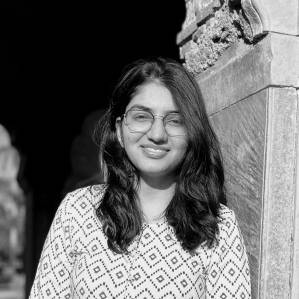India uses approximately 80 percent of its total freshwater supply on agriculture. In a country where 70 percent of rural households depend on agriculture as their primary source of livelihood, this has severe implications.
Agriculture sucks up 89 percent of India’s groundwater, making it the world’s largest consumer of this resource. To add to this, more than half of India’s cultivable land is under water-intensive crops—paddy, sugarcane, wheat, and cotton. While crops such as sugarcane and paddy have a long history of cultivation in India, their cultivation has increased in recent decades, especially in states such as Uttar Pradesh, Maharashtra, Punjab, and Haryana.
The growth of paddy and sugarcane
Paddy, or rice, has been grown as a staple food in many parts of India for centuries. In Punjab, the area under paddy cultivation was just 6.9 percent in 1970–71. Over time it has become the third largest producer of rice in the country, with 87 percent of total area under kharif (seeds are sown at the onset of monsoon) cultivation. The main catalyst for this shift was the Green Revolution.
The aim of the Green Revolution was to achieve food security in India. It mainstreamed paddy and wheat in Punjab and created an agriculture ecosystem in which high-yielding variety (HYV) seeds and subsidies on fertilisers and chemicals were introduced, agro-machinery was promoted, and access to water for irrigation and procurement of every grain was ensured. This infrastructure was built to ensure market security for farmers,” explains Sandeep Dixit, director of Centers for International Projects Trust (CIPT), an organisation that works on making water and energy management efficient.
Paddy farmers in Punjab are assured of a minimum support price (MSP) and a guarantee that the government will purchase their crop, which has further incentivised them to cultivate paddy.
Another example of agriculture adapting to the demand ecosystem relates to the cultivation of sugarcane in Uttar Pradesh. Deo Datt Singh, an agribusiness expert and the director of operations at People’s Action for National Integration (PANI), says, “Uttar Pradesh has the perfect climatic conditions for sugarcane cultivation. Over the past three decades, demand has been increasing, and since it is always in demand, farmers started growing it as a cash crop.”
Today, Uttar Pradesh is the second largest producer of sugarcane in India. Anoop Kumar, project coordinator at PANI states, “The opening of sugar mills made sugarcane economically viable for farmers. It is now considered an easy, hardy, and even a ‘lazy’ crop as it is sown just once a year.”
Impact of growing water-intensive crops
Both paddy and sugarcane are water-intensive crops. Depending on where in the country they are grown, up to 5,000 litres of water are needed to produce a kilogram of rice, and 2,000–3,000 litres to produce a kilogram of sugar. India’s water footprint for rice production is by far the highest of all the major rice-producing countries globally.
More than 96 percent of Punjab’s irrigation needs are met through groundwater, and 117 out of 150 blocks in the state are overexploited. Sandeep explains that agriculture in Punjab runs on a subsidised mechanism—electricity is provided free and farm machinery and various agricultural inputs are subsidised. This encourages farmers to dig multiple borewells, deepen them, and run them for many more hours than what the crop requires.
“In flood-irrigated paddy it is recommended to leave water on the field for just 15 days, but farmers leave the field inundated for 30–60 days, leading to severe wastage of water,” adds Sandeep.
Seventy percent of Uttar Pradesh’s groundwater is over-extracted. Deo Datt says, “Rainwater fulfils approximately 30 percent of sugarcane’s water demand. For the rest, farmers rely on diesel pumps to extract groundwater as the state doesn’t have enough electricity to power motor pumps. This increases carbon emissions.”

Course correction
Both PANI and CIPT are helping farmers shift away from inefficient and resource-intensive agricultural practices.
Some of the practices promoted by PANI for water-efficient sugarcane cultivation are:
1. System of sugarcane intensification (SSI)
In this method, sugarcane plant buds are prepared in a nursery and seedlings are transplanted to the fields. Anoop explains the benefits of adopting SSI. “First, planting buds in the nursery guarantees that every seed will germinate. Since there is no wastage of seeds, yield increases by 30–40 percent. Second, while the plants are in the nursery, short-duration crops can be cultivated in the fields, which generates additional income for farmers.”
Traditionally, over the course of cultivation (a duration of 10–12 months) the sugarcane crop has to be irrigated eight to ten times. SSI saves approximately 6,000 cubic metres of water per hectare, as the first two rounds of irrigation are not required. According to Anoop, this is a huge shift and helps farmers who adopt it save 25 percent water.
2. Ridge and furrow method
Before PANI’s interventions, farmers followed a traditional approach wherein the entire field was flooded with water when the sugarcane crop was sown. The ridge and furrow method takes a different approach. Anoop says, “The plants are sown in furrows, and water is supplied only to these furrows for the first three months. It takes half the time to irrigate the furrows in comparison to watering the entire field. This not only saves water but also reduces the carbon footprint of sugarcane cultivation.”
3. Mulching
Earlier, farmers used to burn the leaves left after harvesting half their sugarcane crop (following a practice known as ratooning). Burning produces some carbon, which is good for the soil. But this practice has a grave environmental impact and burnt soil also requires more water. The farmers that PANI works with are now trying mulching instead. Anoop says that instead of burning the leaves, farmers spread them across the field in a 1–1.5-inch-thick layer. This helps the soil retain moisture and inhibits the growth of grass, which in turn saves farmers one round of weeding and irrigation.
The decomposed leaves also act as compost and increase the soil’s water retention capacity. PANI notes that 2,500–3,000 cubic metres of water are retained per hectare—this saves 17–18 percent of the water supply.
Mulching has been one of PANI’s most successful interventions. Within five years of introducing this practice, PANI established it in 95 percent of the area they work in.
4. Intercropping
Sugarcane is planted in rows that are 2–2.5 feet apart. This provides sufficient space to grow two to three lines of pulses, allowing for their simultaneous cultivation with sugarcane, without requiring additional water. PANI has also been testing other crops, such as onion, that can be planted alongside sugarcane.
Techniques used by CIPT to reduce water use in paddy cultivation in Punjab include:
1. Intelligent water-saving technology
Advances in technology enable better decision-making as they help farmers estimate the amount of water their crops need. CIPT deployed tech-based solutions such as tensiometers and soil moisture sensors to measure and assess field water requirements. Punjab Agricultural University (PAU) developed a tensiometer—a low-cost device that measures soil moisture. Between 2009 and 2015, CIPT promoted the use of tensiometers in nine of the most groundwater-depleted districts of central Punjab.
Building on the learnings from the tensiometer, CIPT then deployed digital soil moisture sensors that sent irrigation advisory text messages to farmers to start and stop their pumps based on soil moisture readings. “If farmers follow the SMS recommendations, water consumption could potentially be reduced by 25–30 percent,” adds Sandeep.
2. Alternate wetting and drying
Sandeep says that farmers in Punjab have traditionally flooded paddy fields for 40–60 days, which isn’t necessary. With alternate wetting and drying (AWD), the field is irrigated, and the subsequent round of irrigation is applied only after the standing water has permeated the soil.” This practice can save more than 30 percent water and reduce methane emissions by 48 percent.
3. Crop diversification
Before the Green Revolution, the crop profile in Punjab was quite diverse but the push towards crops such as paddy and wheat created a monocropping culture. In the absence of crop rotation, soil loses its nutrients, which leads to increased use of fertilisers, and pesticides.
Sandeep says that if farmers were to diversify their crops, it would help save water, generate additional income for the farmer, and help improve the quality of soil. The central government has also initiated a crop diversification programme in Punjab to push other crops such as maize, millets, and cotton.
Sowing seeds for a water-secure future
The experience of these organisations demonstrates that it is possible to reduce the amount of water consumed in the cultivation of these crops without negatively impacting productivity. Together, PANI and CIPT work with 90,000 farming households. Many of the techniques they employ can be replicated and scaled to farming communities in other parts of the country. Helping farmers adopt these practices, tools, and technologies can change the footprint of water consumption and ensure water and food security for the country.
—
Know more
- Listen to this podcast that discusses the future of farming in India.
- Learn about the concept of virtual water and the implications of India’s trade in this resource.







